外研版九年级英语上册课件 Module 5 Unit 3 (共38张PPT)
文档属性
| 名称 | 外研版九年级英语上册课件 Module 5 Unit 3 (共38张PPT) |
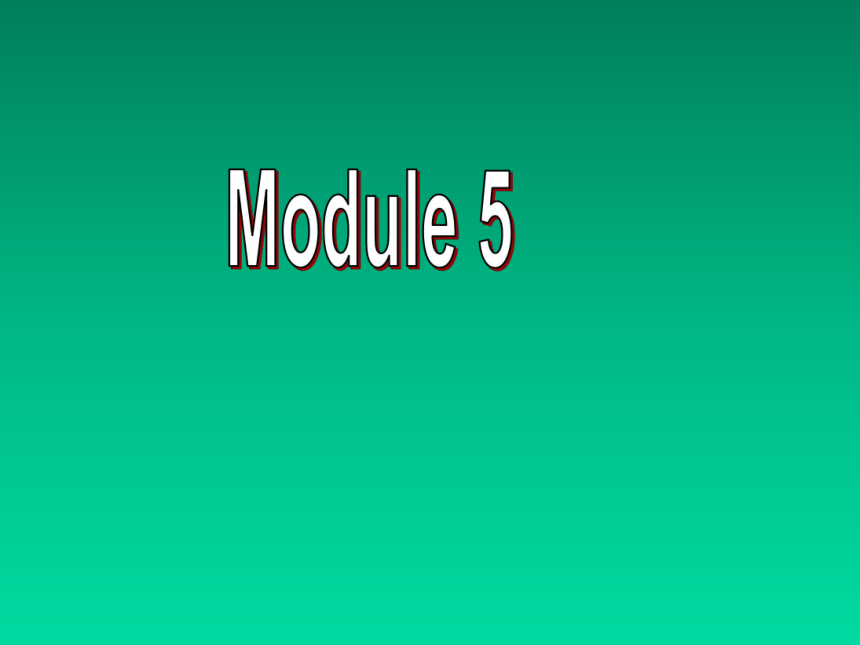
|
|
| 格式 | ppt | ||
| 文件大小 | 2.4MB | ||
| 资源类型 | 教案 | ||
| 版本资源 | 外研版 | ||
| 科目 | 英语 | ||
| 更新时间 | 2022-08-07 08:44:17 | ||
图片预览

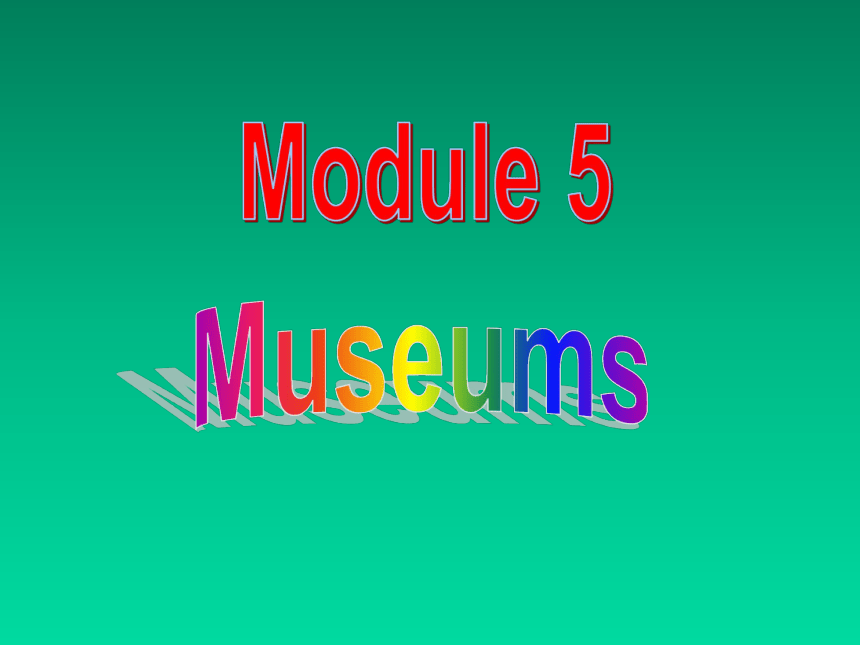
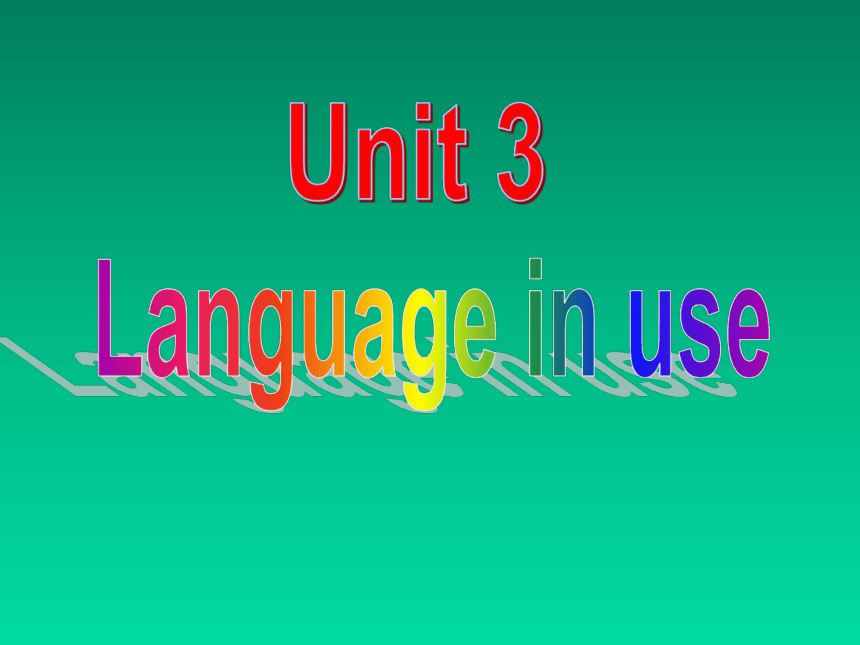
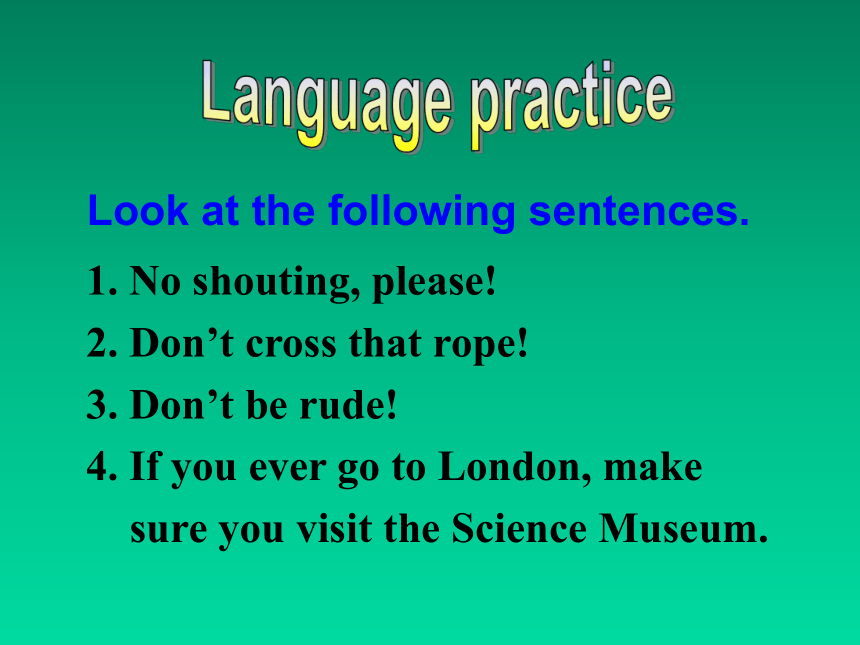
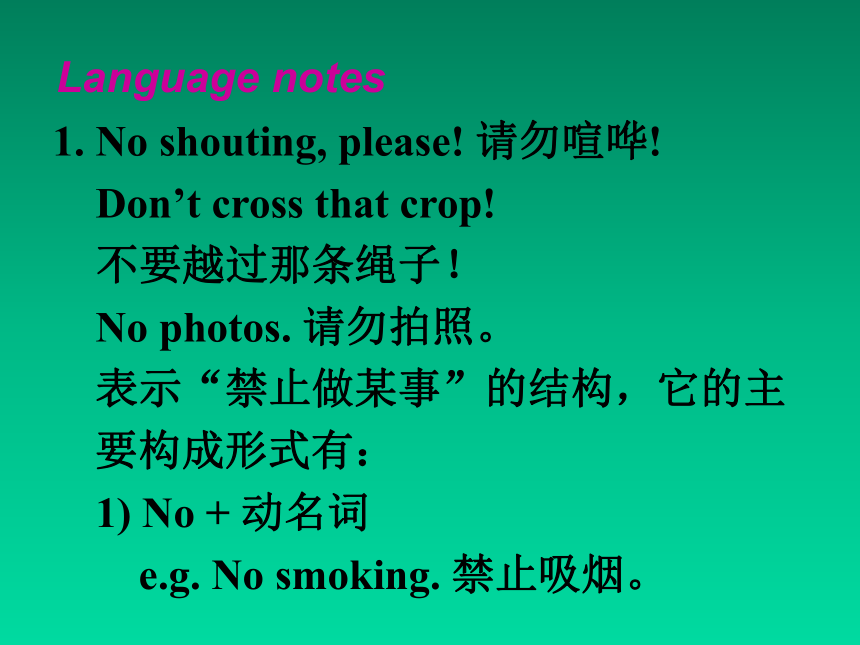

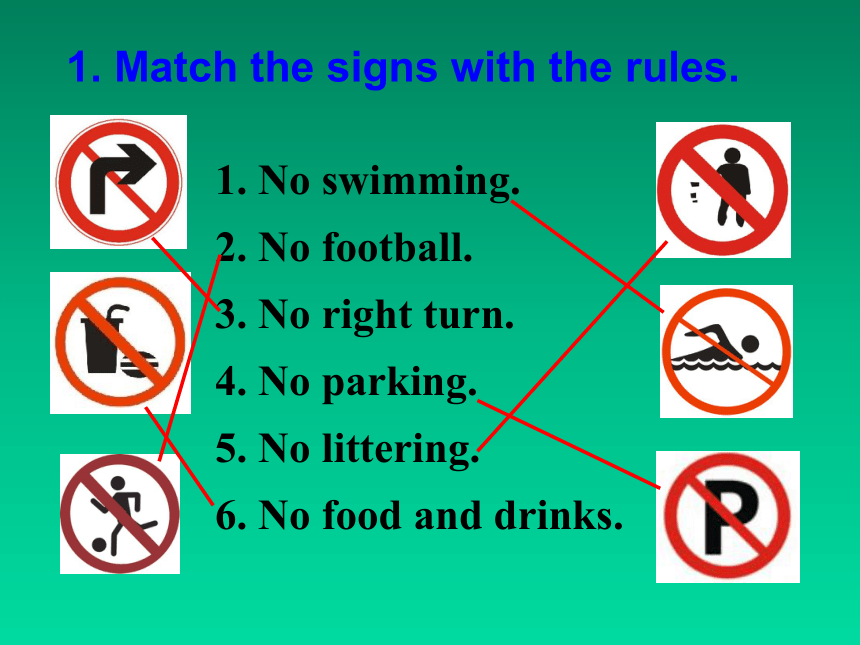

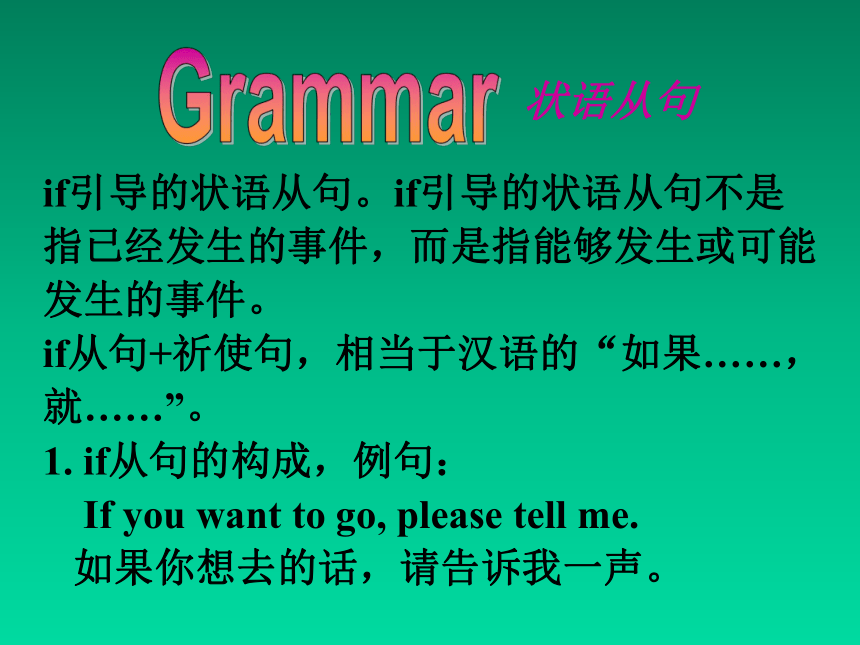



文档简介
(共38张PPT)
1. No shouting, please!
2. Don’t cross that rope!
3. Don’t be rude!
4. If you ever go to London, make
sure you visit the Science Museum.
Look at the following sentences.
1. No shouting, please! 请勿喧哗!
Don’t cross that crop!
不要越过那条绳子!
No photos. 请勿拍照。
表示“禁止做某事”的结构,它的主要构成形式有:
1) No + 动名词
e.g. No smoking. 禁止吸烟。
Language notes
No shouting. 请勿喧哗。
No joking! 不要开玩笑!
2) No + 名词
e.g. No photos. 请勿拍照。
No entry. 请勿入内。
3) 祈使句
祈使句同样可以用来表示“禁止做某
事”。
e.g. Don’t make any noise. 不要吵闹。
Keep off the grass. 请勿践踏草坪。
1. Match the signs with the rules.
1. No swimming.
2. No football.
3. No right turn.
4. No parking.
5. No littering.
6. No food and drinks.
2. Look at the signs and write the rules.
_______________
_______________
_______________
_______________
Don’t touch.
No smoking.
No photos.
No entry.
if引导的状语从句。if引导的状语从句不是指已经发生的事件,而是指能够发生或可能发生的事件。
if从句+祈使句,相当于汉语的“如果……,就……”。
1. if从句的构成,例句:
If you want to go, please tell me.
如果你想去的话,请告诉我一声。
状语从句
If you want to know more about it, call now.
如果你想了解更多内容,现在就打电话吧。
If you want to know what to see, look at the guide.
如果你想知道可参观的内容,就读一下指南吧。
if后面通常接一个完整的句子作从句。
2. if从句的位置
if引导的从句可以放在主句之前,也
可以放在主句之后。例如:
If you ever go to London, make sure you visit the Science Museum.
如果你去伦敦,一定要去参观科学博物馆。可以改写为:
Make sure you visit the Science Museum if you ever go to London.
3. if从句的用法
本模块主要学习并运用“if从句+祈使句”这种结构来表达建议。比如说,如果对方生病了,你建议他去看医生,就可以说:
If you do not feel well, please go to see the doctor.
你如果感觉不舒服,就去看医生吧。
3. Complete the sentences with the
correct form of the words in brackets.
If you ______ (want) to see old
machines, _____ (go) to the museum.
2. If you _______ (visit) London,
______ (take) a boat trip on the river. 3. If the computer does not _____ (start)
immediately, _____ (wait) for
one minute.
want
wait
go
take
visit
start
4. If the weather _____ (get) colder,
______ (put) on more warm clothes.
5. If any student ______ (have) a high
fever, ______ (send) him / her to
the school doctor at once.
6. If you ______ (want) to know how it
works, ______ (read) the book.
put
send
read
gets
has
want
4. Complete the sentences with
your own ideas.
1. If you do not like the TV programme,
__________________.
If you want to join our team, practise more after class.
read a book instead
2. If you want to know where you are,
____________.
3. If you cannot arrive at the station
on time, ______________________
__________.
4. If you need to seed an email, _______
________________________________.
ask someone
call your friends and let
them know
use the
computer at the back of the classroom
5. Work in pairs. Ask and answer
questions about the museum.
Science and Technology Museum
Opening hours
9:00-17:00 Tuesday-Sunday
Charge
Free
What is on
Ground floor: Ancient Technology
First floor: Modern Technology
Second floor: Space Technology
Third floor: Medical Technology
Please note
No shouting. No food.
No smoking. No pets.
No littering.
-What can you see at the museum
-You can see an exhibition about…
-What should you pay attention to in
the Science and Technology Museum
-I should have done: no shouting. No
food…
Contact us
Information desk: 7323 8299
Email: information @
If you want to see ancient technology, go to the ground floor.
If you want to see modern technology, go to the first floor.
If you want to visit the museum, leave your umbrella at the entrance.
…don’t arrive after 5 pm.
…walk, don’t run.
Now write some advice for visitors. Use If.
6. Complete the sentences with the
words or expression in the box.
at, between, inside, into, next to, on
1. The Science and Technology Room is
_____ the third floor.
2. Take the lift to the third floor. It is
over there, _______ the stairs.
3. There is a garden ______ the back
of the building.
on
next to
at
4. You are not allowed to go _______ the
museum without paying.
5. The shop is ________ the ticket office
and the main door.
6. There must be another way ______ the
room.
inside
between
into
7. Complete the passage with the
expressions in the box.
as well, as well as, compare…with,
looking forward to, make sure,
pay attention to
Well, here we are at the Science Museum. Today we will be looking at ancient and modern technology. You can learn about history (1) _________ technology.
as well as
That’s because changes in technology have changed the world. Please (2) ____________ the machines or tools invented in ancient China. They are very important in history and have changed the world forever.
When you write your reports later, (3) _________ that you (4) _________ ancient technology ______ modern technology.
pay attention to
make sure
compare
with
You might include some information about life in ancient and modern times (5) ________.
I’m (6) _________________ reading the reports of your visit.
as well
looking forward to
a) Ancient World
b) A special room
c) Modern World
d) Natural World
e) Restaurant
f) Ticket office
g) Toilet
8. Listen and label the different parts of
the museum.
1
2b
4g
4g
4g
4g
3
5
6
7
f
d
a
c
e
The Louvre
the Mona Lisa
Leonardo da Vinci
The Louvre
No visit to Paris is complete without a trip to the Louvre Museum, one of the largest and most famous art museums in the world. The Louvre is in a beautiful old palace next to the River Seine, but you enter through a modern glass pyramid that the museum added in 1989. Inside, there are about 35,000 works of art.
You can see objects and paintings from different centuries.
Probably the most famous painting in the Louvre is the Mona Lisa by Leonardo da Vinci. He painted it in the early sixteenth century. It shows a young woman smiling.
Everyone who looks at the Mona Lisa wonders what she is thinking about.
Answer the questions.
1. Where is the Louvre Museum
It’s next to the River Seine in Paris.
2. How many works of art are there in
the Louvre Museum
There are about 35,000 works of art
in the Louvre Museum.
3. What can you see in the Louvre Museum
We can see objects and paintings from
different centuries.
4. What’s the most famous painting in the
Louvre Museum
The Mona Lisa by Leonardo da Vinci.
5. When did Leonardo da Vinci paint
the Mona Lisa
In the early sixteenth century.
1. Describe the museum: what kind of
museum it is and what you can see there.
2. Draw a diagram of the museum: what you can find on each floor.
3. Provide more information: how to get to the museum; what the opening hours are; ticket information, etc.
9. Work in groups. Prepare a guide to
a museum.
10. Find or draw pictures for your
guide, showing what you can see
at the museum. Then present
your guide to the class.
1. It will be hard for us to get up in the morning if we ______ to bed too late.
A. go B. went
C. will go D. have gone
2. If I am wanted in the telephone, ask him to leave a ______.
A. message B. letter
C. diary D. sentence
3. —Helen, do you know if Martin
_____ to my party next week
—I think he will come if he _____ free.
A. will come; will be
B. will come; is
C. come; is
D. comes; will be
4. If you want to buy this dress, you’d better _____ first to make sure it fits you .
A. pay for it B. take it off
C. tidy it up D. try it on
Planning a guide to a museum
◆ Describe the museum: what kind of
museum it is and what you can see there.
◆ Draw a diagram of the museum: what
you can find on each floor.
◆ Provide more information: how to get to
the museum; what the opening hours
are; ticket information, etc.
1. No shouting, please!
2. Don’t cross that rope!
3. Don’t be rude!
4. If you ever go to London, make
sure you visit the Science Museum.
Look at the following sentences.
1. No shouting, please! 请勿喧哗!
Don’t cross that crop!
不要越过那条绳子!
No photos. 请勿拍照。
表示“禁止做某事”的结构,它的主要构成形式有:
1) No + 动名词
e.g. No smoking. 禁止吸烟。
Language notes
No shouting. 请勿喧哗。
No joking! 不要开玩笑!
2) No + 名词
e.g. No photos. 请勿拍照。
No entry. 请勿入内。
3) 祈使句
祈使句同样可以用来表示“禁止做某
事”。
e.g. Don’t make any noise. 不要吵闹。
Keep off the grass. 请勿践踏草坪。
1. Match the signs with the rules.
1. No swimming.
2. No football.
3. No right turn.
4. No parking.
5. No littering.
6. No food and drinks.
2. Look at the signs and write the rules.
_______________
_______________
_______________
_______________
Don’t touch.
No smoking.
No photos.
No entry.
if引导的状语从句。if引导的状语从句不是指已经发生的事件,而是指能够发生或可能发生的事件。
if从句+祈使句,相当于汉语的“如果……,就……”。
1. if从句的构成,例句:
If you want to go, please tell me.
如果你想去的话,请告诉我一声。
状语从句
If you want to know more about it, call now.
如果你想了解更多内容,现在就打电话吧。
If you want to know what to see, look at the guide.
如果你想知道可参观的内容,就读一下指南吧。
if后面通常接一个完整的句子作从句。
2. if从句的位置
if引导的从句可以放在主句之前,也
可以放在主句之后。例如:
If you ever go to London, make sure you visit the Science Museum.
如果你去伦敦,一定要去参观科学博物馆。可以改写为:
Make sure you visit the Science Museum if you ever go to London.
3. if从句的用法
本模块主要学习并运用“if从句+祈使句”这种结构来表达建议。比如说,如果对方生病了,你建议他去看医生,就可以说:
If you do not feel well, please go to see the doctor.
你如果感觉不舒服,就去看医生吧。
3. Complete the sentences with the
correct form of the words in brackets.
If you ______ (want) to see old
machines, _____ (go) to the museum.
2. If you _______ (visit) London,
______ (take) a boat trip on the river. 3. If the computer does not _____ (start)
immediately, _____ (wait) for
one minute.
want
wait
go
take
visit
start
4. If the weather _____ (get) colder,
______ (put) on more warm clothes.
5. If any student ______ (have) a high
fever, ______ (send) him / her to
the school doctor at once.
6. If you ______ (want) to know how it
works, ______ (read) the book.
put
send
read
gets
has
want
4. Complete the sentences with
your own ideas.
1. If you do not like the TV programme,
__________________.
If you want to join our team, practise more after class.
read a book instead
2. If you want to know where you are,
____________.
3. If you cannot arrive at the station
on time, ______________________
__________.
4. If you need to seed an email, _______
________________________________.
ask someone
call your friends and let
them know
use the
computer at the back of the classroom
5. Work in pairs. Ask and answer
questions about the museum.
Science and Technology Museum
Opening hours
9:00-17:00 Tuesday-Sunday
Charge
Free
What is on
Ground floor: Ancient Technology
First floor: Modern Technology
Second floor: Space Technology
Third floor: Medical Technology
Please note
No shouting. No food.
No smoking. No pets.
No littering.
-What can you see at the museum
-You can see an exhibition about…
-What should you pay attention to in
the Science and Technology Museum
-I should have done: no shouting. No
food…
Contact us
Information desk: 7323 8299
Email: information @
If you want to see ancient technology, go to the ground floor.
If you want to see modern technology, go to the first floor.
If you want to visit the museum, leave your umbrella at the entrance.
…don’t arrive after 5 pm.
…walk, don’t run.
Now write some advice for visitors. Use If.
6. Complete the sentences with the
words or expression in the box.
at, between, inside, into, next to, on
1. The Science and Technology Room is
_____ the third floor.
2. Take the lift to the third floor. It is
over there, _______ the stairs.
3. There is a garden ______ the back
of the building.
on
next to
at
4. You are not allowed to go _______ the
museum without paying.
5. The shop is ________ the ticket office
and the main door.
6. There must be another way ______ the
room.
inside
between
into
7. Complete the passage with the
expressions in the box.
as well, as well as, compare…with,
looking forward to, make sure,
pay attention to
Well, here we are at the Science Museum. Today we will be looking at ancient and modern technology. You can learn about history (1) _________ technology.
as well as
That’s because changes in technology have changed the world. Please (2) ____________ the machines or tools invented in ancient China. They are very important in history and have changed the world forever.
When you write your reports later, (3) _________ that you (4) _________ ancient technology ______ modern technology.
pay attention to
make sure
compare
with
You might include some information about life in ancient and modern times (5) ________.
I’m (6) _________________ reading the reports of your visit.
as well
looking forward to
a) Ancient World
b) A special room
c) Modern World
d) Natural World
e) Restaurant
f) Ticket office
g) Toilet
8. Listen and label the different parts of
the museum.
1
2b
4g
4g
4g
4g
3
5
6
7
f
d
a
c
e
The Louvre
the Mona Lisa
Leonardo da Vinci
The Louvre
No visit to Paris is complete without a trip to the Louvre Museum, one of the largest and most famous art museums in the world. The Louvre is in a beautiful old palace next to the River Seine, but you enter through a modern glass pyramid that the museum added in 1989. Inside, there are about 35,000 works of art.
You can see objects and paintings from different centuries.
Probably the most famous painting in the Louvre is the Mona Lisa by Leonardo da Vinci. He painted it in the early sixteenth century. It shows a young woman smiling.
Everyone who looks at the Mona Lisa wonders what she is thinking about.
Answer the questions.
1. Where is the Louvre Museum
It’s next to the River Seine in Paris.
2. How many works of art are there in
the Louvre Museum
There are about 35,000 works of art
in the Louvre Museum.
3. What can you see in the Louvre Museum
We can see objects and paintings from
different centuries.
4. What’s the most famous painting in the
Louvre Museum
The Mona Lisa by Leonardo da Vinci.
5. When did Leonardo da Vinci paint
the Mona Lisa
In the early sixteenth century.
1. Describe the museum: what kind of
museum it is and what you can see there.
2. Draw a diagram of the museum: what you can find on each floor.
3. Provide more information: how to get to the museum; what the opening hours are; ticket information, etc.
9. Work in groups. Prepare a guide to
a museum.
10. Find or draw pictures for your
guide, showing what you can see
at the museum. Then present
your guide to the class.
1. It will be hard for us to get up in the morning if we ______ to bed too late.
A. go B. went
C. will go D. have gone
2. If I am wanted in the telephone, ask him to leave a ______.
A. message B. letter
C. diary D. sentence
3. —Helen, do you know if Martin
_____ to my party next week
—I think he will come if he _____ free.
A. will come; will be
B. will come; is
C. come; is
D. comes; will be
4. If you want to buy this dress, you’d better _____ first to make sure it fits you .
A. pay for it B. take it off
C. tidy it up D. try it on
Planning a guide to a museum
◆ Describe the museum: what kind of
museum it is and what you can see there.
◆ Draw a diagram of the museum: what
you can find on each floor.
◆ Provide more information: how to get to
the museum; what the opening hours
are; ticket information, etc.
同课章节目录
- Module 1 Wonders of the world
- Unit 1 It's more than 2,000 years old.
- Unit 2 The Grand Canyon was not just big.
- Unit 3 Language in use
- Module 2 Public holidays
- Unit 1 My family always go somewhere interesting a
- Unit 2 We have celebrated the festival since the f
- Unit 3 Language in use
- Module 3 Heroes
- Unit 1 She trained hard,so she became a great play
- Unit 2There were few doctors, so he had to work ve
- Unit 3 Language in use
- Module 4 Home alone
- Unit 1 I can look after myself, although it won’t
- Unit 2 I became so bored with their orders that I
- Unit 3 Language in use
- Module 5 Museums
- Unit 1 Don't cross that rope!
- Unit 2 If you ever go to London, make sure you vis
- Unit 3 Language in use
- Module 6 Problems
- Unit 1 If I start after dinner, I'll finish it be
- Unit 2 If you tell him the truth now, you will sho
- Unit 3 Language in use
- Revision Module A
- Module 7 Great books
- Unit 1 We're still influenced by Confucius's idea
- Unit 2 It is still read and loved.
- Unit 3 Language in use
- Module 8 Sports life
- Unit 1 Daming wasn't chosen for the team last time
- Unit 2 He was invited to competitions around the w
- Unit 3 Language in use
- Module 9 Great inventions
- Unit 1 Will computers be used more than books in t
- Unit 2 Will books be replaced by the Internet?
- Unit 3 Language in use
- Module 10 Australia
- Unit 1 I have some photos that I took in Australia
- Unit 2 The game that they like most is Australian
- Unit 3 Language in use
- Module 11 Photos
- Unit 1 He's the boy who won the photo competition
- Unit 2 The photo which we liked best was taken by
- Unit 3 Language in use
- Module 12 Save our world
- Unit 1 If everyone starts to do something, the wor
- Unit 2 Repeat these three words daily: reduce, reu
- Unit 3 Language in use
- Revision Module B
